
The East Kent Railway (EKR) is a heritage railway in Kent, England. It is located at Shepherdswell station on the London to Dover Priory direct mainline. The line was constructed between 1911 and 1917 to serve the Kent Coalfields. See East Kent Light Railway for details of the original lines. The Kent Collieries were mostly a failure with only Tilmanstone on the line producing any viable commercial coal and commercial traffic over the line. The line is operated by heritage diesel locomotives. It is home to a collection of heritage diesel locomotives, Diesel Multiple Units DMU, DEMU and electric multiple units including an in service British Rail Class 404 built in the 1930s.

The British RailClass 411 (4CEP) electric multiple units were built at Eastleigh works from 1956–63 for the newly electrified main lines in Kent. These units, which used a British Railways Mark 1 bodyshell, were based on the earlier Southern Railway 4 COR design, built in 1937. Variants of the class 411 design included the class 410 and class 412 4 BEP units, which contained a buffet car in place of a standard trailer. They were later used on services in Sussex and Hampshire; following the privatisation of British Rail in 1995, the units were used by the Connex South Central, Connex South Eastern and South West Trains franchises. They were replaced by Juniper, Desiro, and Electrostar units. The fleet's lifespan was 49 years. These units are the longest-lived BR Mark 1 EMUs.

The British Rail Class 488 are unpowered trailer sets, converted from Mark 2F coaches for the Gatwick Express service from London Victoria to Gatwick Airport.
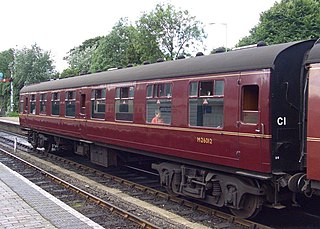
The Second Corridor type of railway carriage was one of the standard mid-20th century designs, and was coded SK by the LNER and BR, and CF by the LMS. The layout of the coach was a number of compartments, all of which were second class, linked by a side corridor.
The Strathspey Railway (SR) in Badenoch and Strathspey, Highland, Scotland, operates a 10 miles (16 km) heritage railway from Aviemore to Broomhill, Highland via Boat of Garten, part of the former Inverness and Perth Junction Railway which linked Aviemore with Forres. It is one of only a handful of primary/secondary main lines to be preserved in Britain today.
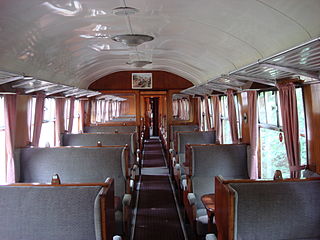
British Railways Mark 1 is the family designation for the first standardised designs of railway carriages built by British Railways (BR) from 1951 until 1974, now used only for charter services on the main lines or on preserved railways.

The Mark 2 family of railway carriages are British Rail's second design of carriages. They were built by British Rail workshops between 1964 and 1975. They were of steel construction.

The British Rail Mark 3 is a type of passenger carriage developed in response to growing competition from airlines and the car in the 1970s. A variant of the Mark 3 became the rolling stock for the High Speed Train (HST).
A wide variety of hauled coaches have been used on the railways of Ireland. This page lists all those since 1945.
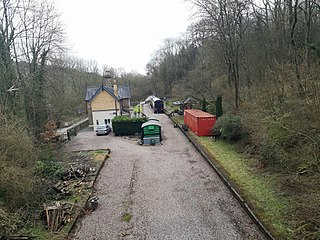
The GWR Coalport railway station, active 1862–1963, was originally built as a single through platform railway station on the Severn Valley Line serving the village of Coalport in Shropshire, England. By January 1896 an additional platform had been added, thus permitting up and down trains to pass along, with a third platform face behind the up platform to form an east-facing bay. By this time, the goods sidings to the east of the station had been expanded.
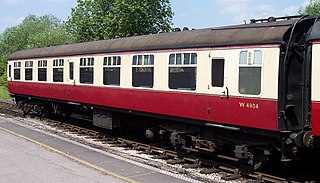
Second Open or Standard Open is a British coach designation for open-saloon second class coaches with 2+1 abreast seating, usually seating 48 passengers. Second class coaches with more conventional 2+2 abreast seating were designated Tourist Second Open (TSO) seating 64 passengers.
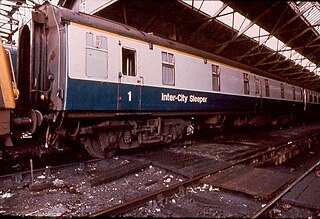
The British Railways Mark 1 sleeping car was a railway sleeping car built by British Railways and outside contractors between 1957 and 1964. Three hundred and eighty cars of three different types were built, with a fourth type created later by conversion. None remain in front-line service and very few are preserved.
The Kent & East Sussex Railway has hosted a variety of heritage rolling stock since the line was closed by British Railways in 1961.
This article is about the rolling stock of the Bluebell Railway.

The Mid-Norfolk Railway has a large collection of heritage rolling stock, mostly relating to the post-war British Railways-era, from the 1950s to 1990s. The line holds several rolling-stock accomplishments:
The Nottingham Heritage Railway is a heritage railway and transport museum on the south side of the village of Ruddington in Nottinghamshire. The route consists of almost 10 miles (16 km) of the former Great Central Railway Main Line from Loughborough South Junction to Fifty Steps Bridge and the site of Ruddington's former GCR station, plus a branch line from Fifty Steps Bridge to Ruddington Fields station which is located on a former Ministry of Defence site next to Rushcliffe Country Park.

The Southern Railway Maunsell carriage was the first design family of railway carriages built by Southern Railway (SR) in the United Kingdom. Following grouping in 1923, SR had continued to build carriages to the designs of the previous three main companies, and the Maunsell carriage was intended to be the standard carriage design for use across the Southern Railway lines, incorporating the best features of each of the former companies' designs.
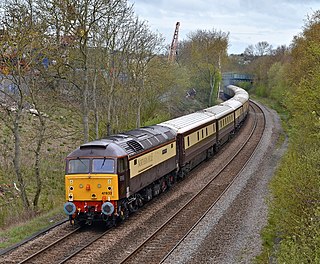
The Northern Belle is a luxury train that operates day and weekend journeys around Britain from many different departure points. The train is named to recall the Belle trains of the 1930s, such as the weekly Northern Belle land cruise; operated by the London & North Eastern Railway every June from 1933 to 1939.
This page outlines the history and evolution of Victorian Railways (Australia) bogie passenger carriages, constructed with steel underframes and timber bodies up to 59 ft 90 in (20.2692 m) long, along with a handful of other carriages from the era.














